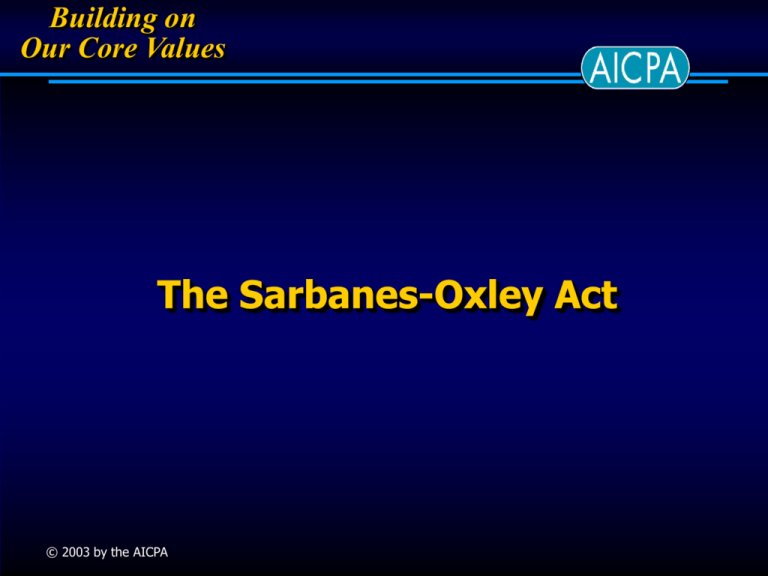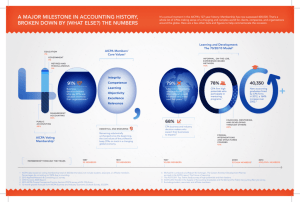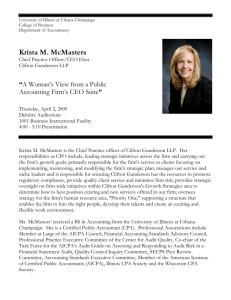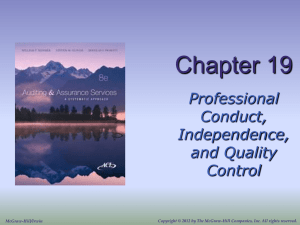
Building on
Our Core Values
The Sarbanes-Oxley Act
© 2003 by the AICPA
This presentation is intended for use in higher education for instructional purposes only, and is not for application in
practice. Permission is granted to classroom instructors to photocopy this document for classroom teaching purposes
only. All other rights are reserved. Copyright © 2003 by the American Institute of Certified Public Accountants, Inc.,
New York, New York.
Building on Our Core Values
The Year of the“Perfect Storm”
Unethical Behavior
Fraudulent Activity
Downturn in the Economy
Massive Business Failures
Audit Failures
Election Year
Result: The most significant legislation
affecting the accounting profession
since 1934
© 2003 by the AICPA
Building on Our Core Values
Sarbanes-Oxley Act of 2002
Enacted July 30, 2002 (nine months after first
announcement of Enron problems)
Applicable to “Issuers” as defined in the SEC Act
of 1934 (approximately15,000 public companies)
–
–
–
–
Companies required to file periodic reports with the
SEC
Companies with more than $1,000,000 in total assets
and at least 500 shareholders
Companies who have registered securities with the
SEC
Companies that are “in registration”
© 2003 by the AICPA
Building on Our Core Values
Sarbanes-Oxley Act of 2002
Creates the Public Company Accounting
Oversight Board or PCAOB, funded by accounting
firms and registrants
Revises corporate governance standards
Adds new disclosure requirements
Creates new federal crimes related to fraud
Significantly increases criminal penalties for
violations of the securities laws
© 2003 by the AICPA
Building on Our Core Values
Public Company Accounting Oversight Board
5 members must be full-time and independent.
Requires 2 CPAs (but only 2) to serve.
Responsible for:
–
–
–
–
Registering all auditors of public companies
Conducting inspections of and discipline of those
auditors
Enforcing compliance with SEC Act of 1934
Establishing and/or adopting auditing, quality control,
ethics, independence, and other standards relating to
the preparation of audit reports for issuers
© 2003 by the AICPA
Building on Our Core Values
Public Company Accounting Oversight Board
Board Inspections and Reports Regarding
Auditors:
–
–
Requires PCAOB to inspect not less than once every 3
years all auditors of public companies
The inspection report becomes public information after
completion of an appeal period, except that any
deficiencies that were resolved within 12 months are
confidential
© 2003 by the AICPA
Building on Our Core Values
Public Company Accounting Oversight Board
Board Investigations and Discipline
–
–
Requires PCAOB to investigate and discipline
violations of the Act, Board rules, securities laws and
professional standards
Requires disciplinary sanctions by the PCAOB to be
reported to “any appropriate State Regulatory Authority”
© 2003 by the AICPA
Building on Our Core Values
Sarbanes-Oxley Act of 2002
Mandates that the PCAOB establish Auditing
Standards to require:
–
Workpaper retention for 5 and 7 years
–
–
Knowing violations of the workpaper retention rules carry
penalties of up to 10 years in prison
CPA firms utilize a second-partner review and approval
of audit reports
Testing of companies’ internal controls, including
reporting of test results
© 2003 by the AICPA
Building on Our Core Values
Sarbanes-Oxley Act of 2002
Auditor Independence
–
Auditor Partner Rotation
–
Prohibits accounting firms from performing certain nonaudit services for audit clients
Requires audit partner and review partner rotation
every 5 years
Requires a 1-year cooling off period
–
Audit firm cannot perform audit if CEO, CFO, controller,
chief accounting officer, etc. was employed by and
participated in the audit 1-year prior to the start of the
audit
© 2003 by the AICPA
Building on Our Core Values
Sarbanes-Oxley Act of 2002
Corporate Governance Standards
–
Audit committees must approve all services to be
provided by the accounting firm
– Required communications between auditor and audit
committee
– Mandatory adoption of a “code of ethics” for senior
financial officers
– Requires CEO and CFO to certify financial reports
© 2003 by the AICPA
Building on Our Core Values
Sarbanes-Oxley Act of 2002
Corporate Governance Standards
–
Prohibits most director and officer loans from the
company
– New rules on director and officer trading of company
stock (insider trading)
– Requires attorney whistleblowing
© 2003 by the AICPA
Building on Our Core Values
Sarbanes-Oxley Act of 2002
Implementation Schedule
–
–
Various requirements of the Act take effect over an
extended period from July 30, 2002, to January 2004.
During this time, the SEC and PCAOB will be issuing
numerous rules and regulations
A number of key SEC rules have completed their comment
period as of the end of January and are now final.
Several others are currently exposed for public comment
Numerous studies mandated by the Act to be
completed by the GAO during this time
Once fully operational, the PCAOB will “put its
stamp” on the implementation of the law.
© 2003 by the AICPA
Building on Our Core Values
SEC Proposals and AICPA Comment Letters
During the past few months, the SEC issued
proposals on many of the SOA provisions.
The AICPA reviewed all proposals to date and
prepared comment letters on each, with special
emphasis on protection of the public interest, as
well as concerns of smaller firms.
Comment letters posted to Sarbanes-Oxley Act/
PCAOB Implementation Central on AICPA.org:
–
http://www.aicpa.org/sarbanes/index.asp
© 2003 by the AICPA
Building on Our Core Values
Implications of Sarbanes-Oxley
for Profession
Potential for loss of audit standard setting
for public company audits
Changing role for SECPS
Disciplinary tie-in to the inspection process
Inspections/peer review coverage of
nonpublic companies
International compliance issues
© 2003 by the AICPA
Building on Our Core Values
Implications for Profession
Potential for limitations on other non-audit
services
New relationship with audit committees and
management
Further consolidation of public audits
Cascade to non-public audits
© 2003 by the AICPA
Building on Our Core Values






